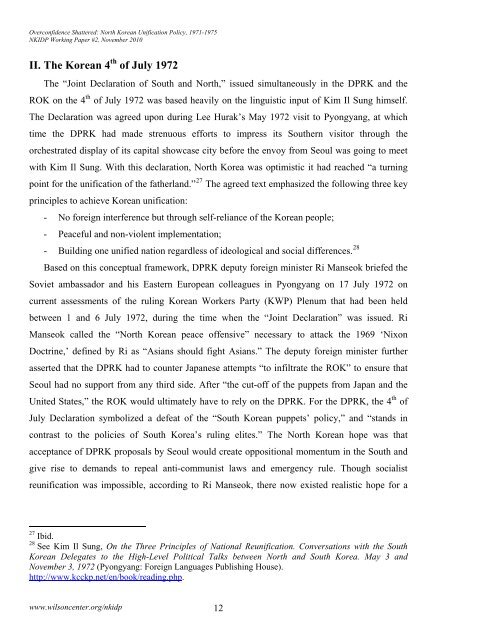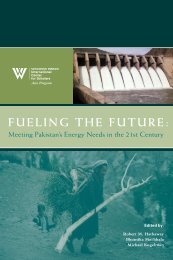Overconfidence Shattered: North Korean Unification Policy, 1971 ...
Overconfidence Shattered: North Korean Unification Policy, 1971 ...
Overconfidence Shattered: North Korean Unification Policy, 1971 ...
- No tags were found...
You also want an ePaper? Increase the reach of your titles
YUMPU automatically turns print PDFs into web optimized ePapers that Google loves.
<strong>Overconfidence</strong> <strong>Shattered</strong>: <strong>North</strong> <strong>Korean</strong> <strong>Unification</strong> <strong>Policy</strong>, <strong>1971</strong>-1975NKIDP Working Paper #2, November 2010II. The <strong>Korean</strong> 4 th of July 1972The “Joint Declaration of South and <strong>North</strong>,” issued simultaneously in the DPRK and theROK on the 4 th of July 1972 was based heavily on the linguistic input of Kim Il Sung himself.The Declaration was agreed upon during Lee Hurak’s May 1972 visit to Pyongyang, at whichtime the DPRK had made strenuous efforts to impress its Southern visitor through theorchestrated display of its capital showcase city before the envoy from Seoul was going to meetwith Kim Il Sung. With this declaration, <strong>North</strong> Korea was optimistic it had reached “a turningpoint for the unification of the fatherland.” 27 The agreed text emphasized the following three keyprinciples to achieve <strong>Korean</strong> unification:- No foreign interference but through self-reliance of the <strong>Korean</strong> people;- Peaceful and non-violent implementation;- Building one unified nation regardless of ideological and social differences. 28Based on this conceptual framework, DPRK deputy foreign minister Ri Manseok briefed theSoviet ambassador and his Eastern European colleagues in Pyongyang on 17 July 1972 oncurrent assessments of the ruling <strong>Korean</strong> Workers Party (KWP) Plenum that had been heldbetween 1 and 6 July 1972, during the time when the “Joint Declaration” was issued. RiManseok called the “<strong>North</strong> <strong>Korean</strong> peace offensive” necessary to attack the 1969 ‘NixonDoctrine,’ defined by Ri as “Asians should fight Asians.” The deputy foreign minister furtherasserted that the DPRK had to counter Japanese attempts “to infiltrate the ROK” to ensure thatSeoul had no support from any third side. After “the cut-off of the puppets from Japan and theUnited States,” the ROK would ultimately have to rely on the DPRK. For the DPRK, the 4 th ofJuly Declaration symbolized a defeat of the “South <strong>Korean</strong> puppets’ policy,” and “stands incontrast to the policies of South Korea’s ruling elites.” The <strong>North</strong> <strong>Korean</strong> hope was thatacceptance of DPRK proposals by Seoul would create oppositional momentum in the South andgive rise to demands to repeal anti-communist laws and emergency rule. Though socialistreunification was impossible, according to Ri Manseok, there now existed realistic hope for a27 Ibid.28 See Kim Il Sung, On the Three Principles of National Reunification. Conversations with the South<strong>Korean</strong> Delegates to the High-Level Political Talks between <strong>North</strong> and South Korea. May 3 andNovember 3, 1972 (Pyongyang: Foreign Languages Publishing House).http://www.kcckp.net/en/book/reading.php.www.wilsoncenter.org/nkidp 12
















